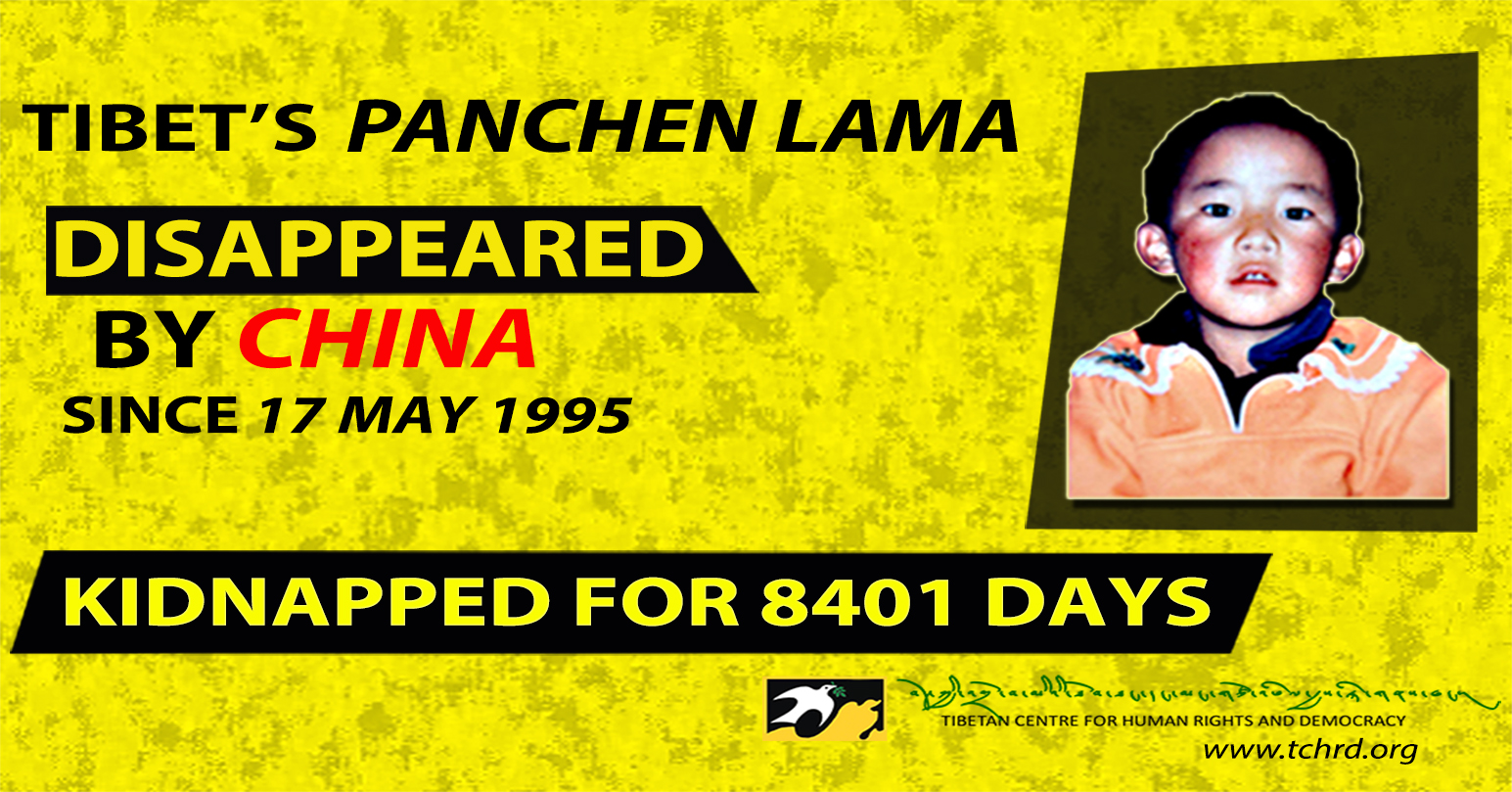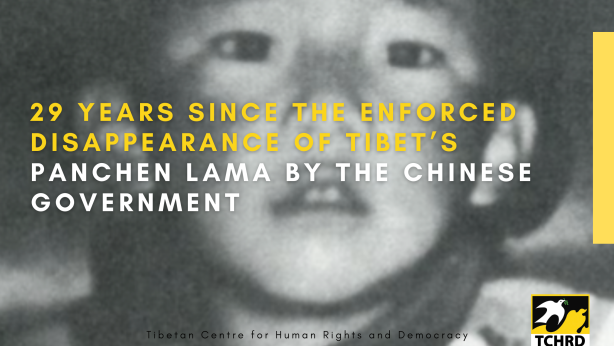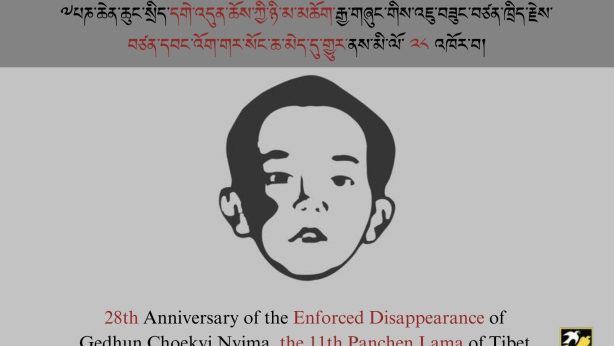China: Allow independent international bodies to verify fate of Gedhun Choekyi Nyima, the 11th Panchen Lama of Tibet
On the 23rdanniversary of the enforced disappearance of Tibetan spiritual leader Gedhun Choekyi Nyima, the Tibetan Centre for Human Rights and Democracy (TCHRD) joins a chorus of voices from the international community demanding China to allow independent bodies to verify, without surveillance and government minders, the fate of the 11thPanchen Lama.
Gedhun Choekyi Nyima was six years old when he and his parents became victims of enforced disappearance at the hands of Chinese authorities on 17 May 1995, three days after His Holiness the Dalai Lama had recognized him as the reincarnation of the previous 10thPanchen Lama. In blatant disregard and violation of the right to freedom of religion and belief of the Tibetan people, Chinese authorities appointed another boy named Gyaltsen Norbu as its choice of Panchen Lama in November 1995.
For the past 23 years, Chinese authorities have willfully misled the international community by making vague and unverifiable claims about the fate and whereabouts of Gedhun Choekyi Nyima. Earlier this month, a delegation of Chinese Communist Party members from Tibet Autonomous Region (TAR) told Canadian lawmakers that Gedhun Choekyi Nyima had probably completed his university education before reiterating the standard response that he was leading a “healthy and happy life” and “did not want to be disturbed”. Without giving any kind of access to ascertain the condition and whereabouts of Gedhun Choekyi Nyima, all claims of his wellbeing remain suspect.
Despite Chinese intransigence and prevarication, the international community has not forgotten the unresolved case of the enforced disappearance of Gedun Choekyi Nyima. Numerous governmental and non-government bodies have continued to question China on the issue and pressing for independent international bodies including the Office of the High Commissioner for Human Rights to be granted access to verify claims made by Chinese authorities. In November 2017, Canadian foreign minister Chrystia Freeland called on China to allow the UN High Commissioner for Human Rights and the UN Special Rapporteur on Freedom of Religion and Belief to visit Gedhun Choekyi Nyima in detention.
Chinese authorities must end the enforced disappearance of Gedhun Choekyi Nyima without any preconditions and respect his human rights to live in freedom and dignity.
Web of Lies
In late November 1995, China’s Foreign Ministry spokesman, Shen Guofang, claimed, “We have no idea about the whereabouts of the so-called soul boy determined by the Dalai Lama.” He denied that Gedhun Choekyi Nyima and his family had spent the last few months in detention in Beijing and added that “he is not missing, nor is he incarcerated,” but that “he should be wherever he was born.” On 28 May 1996, China finally admitted to holding Gedhun Choekyi Nyima and his family at a secret location. This announcement came after a request by the UN Committee on the Rights of the Child asked for the disclosure of the boy’s whereabouts. As Wu Jianmin, Ambassador of China to the UN put it: “[Gedhun Choekyi Nyima] has been put under the protection of the government at the request of his parents.” Wu did not say where the child was being held. At that time, Chinese state media reported that, “the boy was at the risk of being kidnapped by separatists and his security had been threatened.”
In 1997, two Western delegations to Tibet, one of which included the Austrian Foreign Minister Wolfgang Schuessel and the other a group of American religious leaders of three different faiths, were given conflicting information. The vice-governor of the Tibet Autonomous Region Yang Chuantang told the Austrian group that Gedhun Choekyi Nyima was living in his birthplace of Lhari in Tibet. The group of US clerics had been told that the boy was in Beijing.
In October 2000, during a round of the UK-China bilateral human rights dialogue in London, British officials raised the issue of Gedhun Choekyi Nyima. In a written report to the British Parliament, Foreign Office Minister John Battle stated that: “We pressed the Chinese to allow access to the boy by an independent figure acceptable to the Chinese government and Tibetans to verify his health and living conditions. The Chinese stated that the boy was well and attending school. They said that his parents did not want international figures and the media intruding into his life. Two photographs claimed to be of the Panchen Lama were shown to us but not handed over.” The two photos showed a boy writing in Chinese on a blackboard, and another of a boy playing table tennis. There was no means to positively identify the child, the photos merely showed a boy of approximately the correct age. There was also no means to determine his location.
In August 2001, a Polish Parliamentary delegation visiting Lhasa was told in response to repeated questions that Gedhun Choekyi Nyima and his family were being held in “protective custody” and were healthy; the delegation was promised photos of the boy within six weeks but never received them. Later the Polish government received a letter from the Chinese embassy in Warsaw stating that Gedhun Choekyi Nyima and his parents did not want their peaceful life to be disturbed by strangers, and that the Chinese government “respects freedom of choice for its citizens and hopes that the Polish people would understand that too.”
In October 2001, an Australian delegation was told that the parents of Gedhun Choekyi Nyima were insisting that no foreign delegations be allowed to meet him. According to Chinese authorities, the parents have said that “they want their privacy respected, that they particularly don’t want people to have access to the child and they want him to live a normal life and they don’t want to be bothered by people.”
In March 2002, a Chinese government delegation from the TAR met with a European Parliament delegation and once again said that Gedhun Choekyi Nyima did not wish to be disturbed. The delegation refused to answer questions about photographs promised to the Polish delegation.
Background
On 14 May 1995, His Holiness the Dalai Lama announced the recognition of Gedhun Choekyi Nyima as the reincarnation of the previous 10th Panchen Lama. On 15 May, the Chinese government issued a statement rejecting the Dalai Lama’s selection. This was followed on 17 May with the abduction of Panchen Lama and his parents from their home in Lhari County. They have never been seen or heard from again. On 29 November, spurred by political motives, Chinese government appointed Gyaltsen Norbu, as its choice of 11th Panchen Lama.
Chinese appointment of a rival Panchen Lama to nullify the Dalai Lama’s choice sparked deep and widespread resentment among Tibetans who continue to protest and call for Gedhun Choekyi Nyima’s release. Sustained pressure from the international community led to Chinese government admitting on 14 May 1996 that it was holding Gedhun Choekyi Nyima, purportedly to provide security for the ‘ordinary boy against suspected attempts by splittist groups to kidnap him’. Many in the international community have called on Chinese government to account for the enforced disappearance of Panchen Lama and his parents. So far, Chinese government has failed to provide any evidence on the safety and well-being of the Panchen Lama and his parents.
The Tibetan system of reincarnation is not defined by political appointments, popular elections, name and status of the position. It is determined by the spiritual necessity to continue the specific lineage in order to carry out the teachings of the former lineage holder. The recognition of reincarnation through the traditional Tibetan system involves manifestations of particular signs, prophesies that are held to tests following intricate religious principles and rituals. China’s politicised system of reincarnation has effectively removed the role of traditional Tibetan religious practices and threatened the survival of Tibetan identity by destroying its religion and culture, customs and traditions.



